Ickleford Squash Ranking System
Introduction
The original squash ranking system was fairly simplistic and
was just based on the principle that if you beat a player with a better ranking
than yourself, then your ranking was improved and your opponents ranking was
degraded. However, if you lost to a player with a better ranking than
yourself, then both players rankings remained unchanged.
This system worked reasonably well, however it did tend to
pull player rankings together into clumps.
After some investigation on the Internet, the ranking system
used by Avon and Bristol District Squash
looked impressive and has been adapted for use by Ickleford Squash Club.
Improved System
The new Ickleford Ranking System is based on a logarithmic
scale of ability whereby the difference between any two players rankings is a
measure of their relative ability as follows:-
|
Ranking Difference
|
Relative ability
|
|
0
|
Players are equal ability
|
|
20
|
Player with the lower ranking is 2 times better
|
|
40
|
Player with the lower ranking is 4 times better
|
|
60
|
Player with the lower ranking is 8 times better
|
The following graph shows the assumed probability of winning
each point based on the relative ranking.
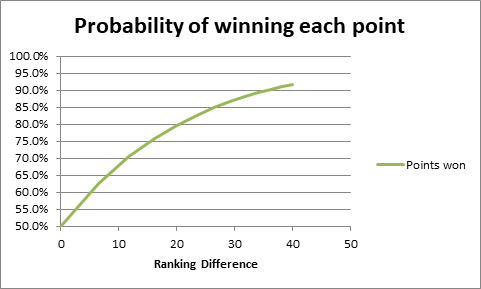
Figure 1
The above graph is largely hypothetical but is very similar
to the Avon and Bristol system, which is based on empirical data. It also
accords quite closely with player experience. Note that two players of the
same ranking (zero difference) have a 50% probability each of winning each
point. A player who is twice as good (ranking difference of 20), has
approximately an 80% chance of winning each point ie. they will win 4 points
out of every 5 on average. As the ranking difference increases, then the
probability of the better player winning each point tends towards 100%, however
there is always a chance that the lesser player will sneak the odd point, so
the line never reaches 100%.
Assuming that the probability of winning each point shown in
Figure 1 is correct, then it is fairly simple to calculate the probability of
match results.
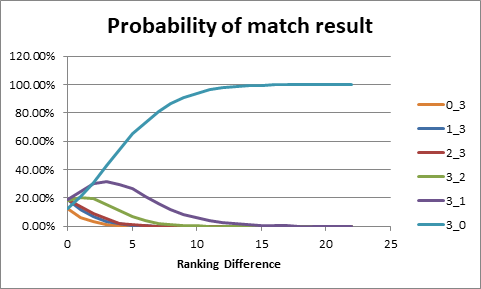
Figure 2
Figure 2 shows the probability of each match result for PAR
scoring to 15 points, best of 5 games. The calculation is based on the
simulation of thousands of matches, where the probability of each point is
taken from the graph in Figure 1. It ignores the possibility of any match not
reaching a full result due to lack of time.
As might be expected, the probability of a 3-0 win by the
better player rises rapidly with increasing ranking difference. The
probability of a 3-0 win is around 60% for a ranking difference of 5, 94% for a
ranking difference of 10, and almost 100% for a ranking difference of 15 or
more.
Interestingly, the probability of a 3-2 win by the better
player never exceeds more than around 20%, and the probability of a 3-1 win by
the better play peaks at around 30% for a ranking difference of 3.
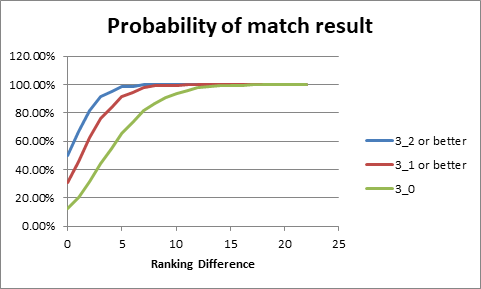
Figure 3
Figure 3 shows the probability of a win by the better
player. This rises even more sharply with increasing ranking difference,
reaching almost 100% for a ranking difference of 5 or more.
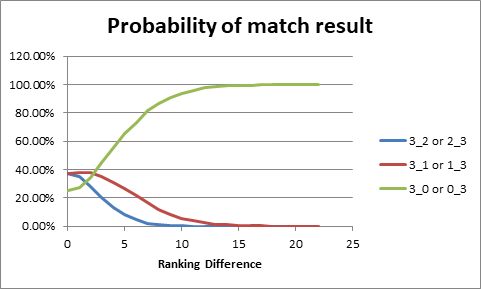
Figure 4
Figure 4 shows the probability of a 3-2, 3-1 and 3-0 wins
either way versus ranking difference. Perhaps surprising, this shows that a
match result of 3-1 either way around is the most likely result for ranking
differences of approximately 2 or less.
Adjusting Rankings
Based on the previous analysis, the following table shows
the most likely ranking difference for each league match result.
|
Match Score
|
Likely ranking difference
|
|
3-0
|
5
|
|
3-1
|
3
|
|
3-2
|
1
|
|
2-2
|
0
|
|
2-1
|
1
|
|
2-0
|
1
|
|
1-1
|
0
|
|
1-0
|
1
|
|
0-0
|
0
|
|
0-1
|
-1
|
|
0-2
|
-3
|
|
0-3
|
-5
|
|
1-2
|
-1
|
|
1-3
|
-3
|
|
2-3
|
-1
|
Table 1
Suppose the better ranking player A has a ranking of RA
before the match and the other player B has a ranking of RB.
The ranking difference is:-
Rank_Diff = RB – RA
Rank_Diff is then limited to be in the range -10 to +10.
This is designed to avoid extreme changes of ranking when comparing players of
very different abilities.
The most likely ranking difference based on the match result
is taken from Table 1
Rank_Delta = Rank_Deltas(GamesA, GamesB)
where GamesA is the number of games won by player A and
GamesB is the number of games won by player B
Next we calculate what the error is in the current ranking
difference
If
Match_Score = “3-0” and Rank_Diff > 5 Then
‘Do
nothing, since the match went according to expectation
Rank_Error
= 0
Else
Rank_Error = Rank_Delta - Rank_Diff
End If
Then we adjust the player rankings to reduce the error,
using a suitable weighting factor in order to smooth the changes. If one of
the players has a provisional ranking (and the other doesn’t), then only the provisional
player’s ranking is adjusted.
If both
players have an established ranking Then
Delta = 0.25 * Rank_Error
RA = RA – Delta
RB = RB + Delta
ElseIf both
player have a provisional ranking Then
Delta = 0.5 * Rank_Error
RA = RA – Delta
RB = RB + Delta
ElseIf
Player A has a provisional ranking Then
Delta = 0.5 * Rank_Error
RA = RA – Delta
ElseIf
Player B has a provisional ranking Then
Delta = 0.5 * Rank_Error
RB = RB + Delta
End If
Let’s look at a concrete example of two players with an
established ranking.
RA = 22
RB = 27
Match score is 3-2 to player A
Rank_Diff = 5
Rank_Delta = 1
Rank_Error = Rank_Delta – Rank_Diff = -4
Delta = 0.25 * Rank_Error = -1
Therefore, the ranking of player A is increased (worsened)
to 23, and the ranking of player B is decreased (improved) to 26. This is
despite the fact that Player A actually won the match 3-2. The logic behind
this, is that with a handicap difference of 5, Player A should be expected to
win the match 3-0.
Taking another example.
RA = 22
RB = 23
Match score is 3-0 to player A
Rank_Diff = 1
Rank_Delta = 5
Rank_Error = Rank_Delta – Rank_Diff = +4
Delta = 0.25 * Rank_Error = +1
Therefore, the ranking of player A is decreased (improved)
to 21, and the ranking of player B is increased (worsened) to 24. This is
because Player A was expected to win the match 3-2, but actually won the match
3-0.
Handicapped Competitions
For a handicapped competition, if the handicaps are correct,
then we would expect each match to end in a draw, or at least be very close.
From Figure 1, we can calculate the probability of the
better player winning each point based on the handicap difference between the
two players. Suppose the probability is PA.
For an American 25 point competition match, we would expect
players of equal ranking to start at 0-0 and to play a total of 50 points per
game. So, setting the total number of points that we want to be played per
game to 50, then player A will win a total of 50 * PA points and
player B will win a total of 50 * (1-PA) points. So to achieve a draw,
player A should start on 25 – 50 * PA points and player B should
start on 25 – 50 * (1-PA) points.
Plotting this:-

Figure 5
Similarly for an American 15 point tournament.
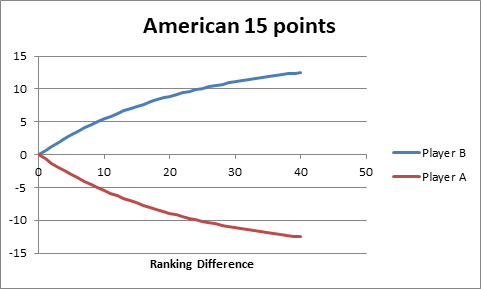
Figure 6
Ideally, following each handicapped tournament match, we
would use the number of points won by each player in order to adjust the
handicaps suitably. However, since the game scores aren’t normally recorded,
just the overall match result, it is proposed to adjust the player handicaps by
1 for each match played depending on the result ie. the winner’s handicap will
be decreased (improved) by 1 and the loser’s handicap will be increased
(worsened) by 1.
Assuming that there are 4 rounds in the competition, the
overall winner will therefore have their handicap improved by 4, thus
decreasing the likelihood that they will win the competition next time.
At the moment, these handicap adjustments will be made
manually after the end of the completion, whereas the handicap adjustments made
as a result of league matches will be made automatically when the leagues are
processed at the end of each month. At some point, we may automate the
competition handicap adjustments as well.
Questions
Q) I won all of my league matches and yet my
handicap has worsened. How is this possible?
A) This is unusual, however if your handicap is
such that you are expected to beat your opponents convincingly and you only win
your matches by small margins, then your handicap might suffer.
Q) Wouldn’t it be better to actually use the points
scored each game in order to adjust the handicaps.
A) Yes, quite possibly. However this would
require significant changes to the website and leagues application software in
order to allow points each games recorded. Besides which, it might also be difficult
to remember the points scored each game unless they are recorded immediately.
The new system of using the games scored should at least represent a
significant improvement over the old system.
Q) What constitutes a provisional ranking.
A) When a new player enters the ranking system
they are given a provisional ranking. The provisional status indicates that
there is a high level of uncertainty about their actual ranking. Once a player
has played in the leagues for 2 months and their results are ‘normal’ ie. they
don’t win/lose most of their matches 3-0, then their ranking becomes
established.